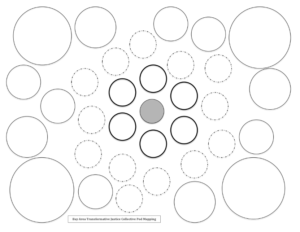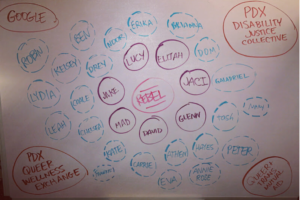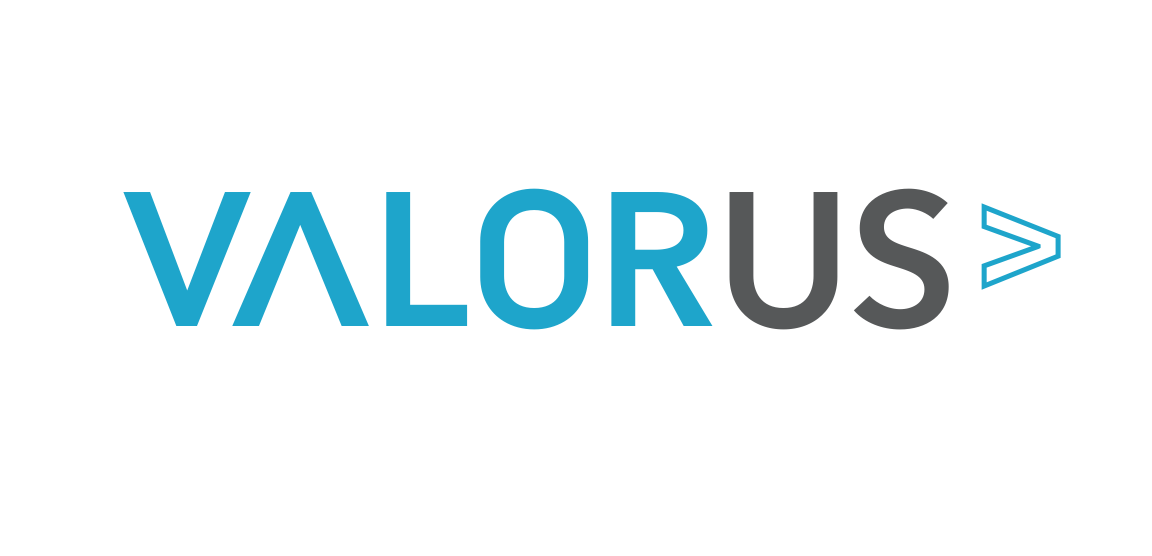Pods and Pod Mapping Framework
Mia Mingus and others at the Bay Area Transformative Justice Collective (BATJC) have trained extensively on Pods and Pod Mapping as a strategy for alternative models of justice. BATJC describes Pods as “…a term to describe the kind of relationship between people who would turn to each other for support around violent, harmful and abusive experiences, whether as survivors, bystanders or people who have harmed.” Pod work is rooted in transformative justice principles of harm and accountability, including a community-based approach to intervening in and preventing violence at all levels.
The basic framework of pod mapping is to clearly document one’s own support networks and to facilitate conversations about violence intervention within those networks before it occurs. The Pod Mapping Worksheet, featured below, allows participants to write their own name in the grey middle circle and encourages them to clearly write in the names of their pod people in the surrounding concentric circles. The names of established community networks (like Rape Crisis and LGBTQ+ Centers) are reserved for the outer circles.

In her Pods 101 Training, Mingus encourages participants to select their pod people not based only on the closeness of the relationship, but taking into consideration a particular set of skills that the participant would find helpful in a crisis. She suggests to consider other factors such as capacity and proximity when filling in the worksheet. Mingus also stresses the importance of obtaining consent from potential pod people rather than assuming that they have the desire or capacity to be in the pod.
In the Pod Mapping write up, BATJC writes “People can have multiple pods. The people you call to support you when you are being harmed may not be the same people you call on to support you when you have done harm, and vice versa. In general, pod people are often those you have relationship and trust with, though everyone has different criteria for their pods.”
Pod Mapping can also be used in times of economic and natural disasters. On Westcott Mutual Aid’s website, Rebel Sydney Black suggests a framework for having conversations with pod people in reference to COVID-19 mutual aid such as “Do you want to be part of my disaster survival mutual aid pod? OK cool, what do you feel like you can contribute? I can bring meals and groceries, provide emotional support, and have a couple extra inhalers. We have a safe place where you can come and stay in our guest room if you need it.” Rebel also offers an example of their own pod mapping worksheet, featured below.

How Does Pod Mapping Address Prevention?
In her Pods 101 Training, Mingus discusses utilizing the pod framework for low-level bystander intervention. As she draws an L shape on a piece of chart paper, she explains that as a society, we typically respond to violence only when it has reached a certain level of severity, sustained over a long period of time. Micro-level violence occurs consistently, and most individuals in a community do not feel as if they have the skills to address it. Often times, if someone in our community is accused of causing sexual harm, we can reflect back to times when we witnessed problematic behavior or misogynist language and we wish had known how to intervene, wondering if the more severe harm could have been prevented.
Pod work is not intended to only address serious impact, rather, it is a framework to normalize having conversations and skill building in one’s own networks to call out violence in its most minute forms. For example, pod people might discuss with one another how to hold each other accountable in safe and effective ways. An individual might hear from someone in their pod that their statement was actually a microaggression, misogynist, or anti-Black – this intervention calls attention to the problematic behavior and allows the person who caused impact to make behavioral change before harmful situations escalate. These practices are more effective when addressed before violence occurs as emotions are not as high. Additionally, they often require practice and skill building in accountability and how to give a good apology.
Pod mapping can also be used in a similar fashion with children and teens to help them identify safe people in their sphere that they can rely on for support during emotional or physical crises. Depending on the age of the young person, their pod worksheet might consist of all adults or a mix of adults and peers. Rather than focusing on broader concepts of accountability, adults in their life can help them think through logistical questions such as “How do I tell a friend that they hurt my feelings/made me mad/caused harm?” or “My friend told me that I caused harm – how do I let them know I’m sorry?” Other concepts such as intention versus impact and the evolution of relationships can be pertinent to address with youth as well. The Pod Mapping tool can be particularly effective with youth leadership teams or other violence prevention youth centered spaces, however, communities of youth and adults alike can benefit from this innovative tool.


